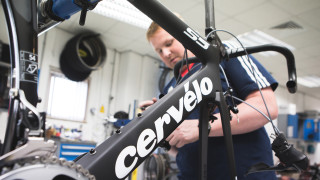Knowledge Level: Intermediate
Although now a ubiquitous bike frame material, carbon still has its sceptics and myths about its fragility still abound. Who better to sort myth from fact than Richard Matthews, composite engineer at Cervélo, elite road and track bike partner to the Great Britain Cycling Team.
Does carbon have a limited lifespan?
Carbon fibre composites, in general, actually have a longer life span than many metals, such as aluminium. While most metal structures will fatigue, or decrease in strength, over time, the nature of the microstructure of carbon fibre composites makes them far less susceptible to fatigue damage over time. We have seen that many of our frame designs have basically an infinite fatigue life when designed accordingly. However, when making very lightweight designs, margins are reduced for unexpected or non-design loads – such as dropping on a kerb or crashing. In reality, especially for racing bikes, damage from a crash will often lead to a frame being discarded long before it would ‘wear out’ in normal use.
Are carbon frames more susceptible to damage than other frame materials?
As mentioned above, carbon fibre composite can actually be stronger than most metals, depending on the design intent. Look at something like a Formula 1 car. The carbon fibre main tub can survive a crash into a wall at hundreds of miles an hour without injuring the driver. A metal design for this structure would never be able to survive such a crash. One of the reasons carbon fibre composites are able to do this is because their strength is highly directional. A good analogy is wood. It is very strong in the direction of the grain structure, but if you try and bend it across the grain it will snap easily. The same is true for carbon fibre composites. This means that when designing for minimum weight, the frame can be very strong in the directions it is designed to work in (sitting on the saddle) but can be weak in other directions (when hitting on the side of a tube with an object). It all comes down to priorities in design.
Is carbon damaged by heat or cold?
Carbon fibre composites are designed to work over an extreme range of temperatures. Unlike alloys, the material properties of carbon fibre composites remain mostly stable from sub-zero temperatures all the way up to scorching desert heat. Depending on the exact materials chosen, most bike frames would be unaffected by temperatures exceeding 100C, although the paint and cosmetic finishes might give way long before the frame does.
Can carbon be repaired if it gets damaged
Absolutely, carbon fibre composites are a highly repairable and modifiable material. This is already a common practice in the aerospace, marine and automotive industry. Right now, the capabilities and infrastructure in the cycling industry are not as mature as in those other fields. However, there are a number of facilities all over the world who can cost effectively repair most damage to carbon fibre composite frames.
What should I use to clean my carbon bike?
Generally, mild soap and water are the best cleaning agents for a carbon fibre composite bike frame. You should never use aggressive solvents as these can damage the paint finish or even the frame material itself in some cases. Pressure washers will not damage carbon fibre materials themselves, but they can force water into places it would not normally get, especially in the mechanical components like bearings and shifters, so they should be used with caution.

What's assembly paste and should I use it?
Assembly paste, commonly called carbon assembly paste or friction paste, is a special high friction paste used to increase the friction between two parts. The reason it is used often on carbon fibre composite parts is that these materials generally have a quite slippery surface finish, much more so than bare metals. In order to reduce the chance of slip in some joints (like a seat post clamp), the assembly paste is used to increase the friction between the two parts. Although it looks like grease, it has the opposite effect and grease (which reduces friction) should never be used as a substitute for assembly paste. Always follow the manufacturer’s recommendations in applying assembly paste to carbon fibre composite parts.
Do I need to use a torque wrench?
You should definitely use a torque wrench when tightening fasteners holding carbon fibre composite parts together. In general, torque wrenches should always be used when tightening important threaded fasteners (you would definitely want them to be used when fastening the wheels on your car, for instance). As mentioned before, carbon fibre composite parts in lightweight designs can have less residual strength than heavier metal parts, so it can be possible to damage them if over tightening a bolt. In addition, the lower coefficient of friction mentioned above also makes these parts more likely to slip if not tightened enough. This means that using a torque wrench is the best way to ensure proper performance (no slip) without damaging your bike. I would recommend using a torque wrench even on a metal bike frame, especially if it is a lightweight design as it can be just as susceptible from damage due to over-tightening. Of course, on a bicycle many safety critical fasteners can be adjusted by the consumer (like bar and stem clamps) and you would not want these to come loose while riding, so you should always use a torque wrench to ensure proper tightening and safety of your bicycle, regardless of what material it is made from.



















